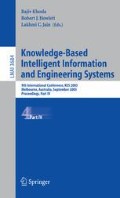Abstract
Web applications based on description logics often need management of fuzzy information and encounter fuzzy concepts. This paper proposes an extended fuzzy ALCN to enable representation and reasoning for complex fuzzy information. The extended fuzzy ALCN introduces the cut sets of fuzzy concepts and fuzzy roles as atomic concepts and atomic roles, and inherits the concept constructors from description logics to support a new logic system. This paper defines its syntax structure, semantic interpretation and reasoning problems. The extended fuzzy ALCN is more expressive than the existing fuzzy description logics and present more wide fuzzy information.
This work was supported in part by the NSFC (60373066, 60425206, 90412003), National Grand Fundamental Research 973 Program of China (2002CB312000), National Research Foundation for the Doctoral Program of Higher Education of China (20020286004)
Access this chapter
Tax calculation will be finalised at checkout
Purchases are for personal use only
Preview
Unable to display preview. Download preview PDF.
References
Berners-Lee, T., Hendler, J., Lassila, O.: The Semantic Web. Scientific American 284(5), 34–43 (2001)
Baader, F., Calvanese, D., McGuinness, D.L., Nardi, D., Patel-Schneider, P.F. (eds.): The Description Logic Handbook: Theory, Implementation, and Applications. Cambridge University Press, Cambridge (2003)
Meghini, C., Sebastiani, F., Straccia, U.: Reasoning about the form and content for multimedia objects. In: Proceedings of AAAI 1997 Spring Symposium on Intelligent Integration and Use of Text, Image, Video and Audio, California, pp. 89–94 (1997)
Schmidt-Schauß, M., Smolka, G.: Attributive concept descriptions with complements. Artificial Intelligence 48, 1–26 (1991)
Straccia, U.: Reasoning within fuzzy description logics. Journal of Artificial Intelligence Research (14), 137–166 (2001)
Straccia, U.: Transforming fuzzy description logics into classical description logics. In: Proceeedings of the 9th European Conference on Logics in Artificial Intelligence, Lisbon, pp. 385–399 (2004)
Author information
Authors and Affiliations
Editor information
Editors and Affiliations
Rights and permissions
Copyright information
© 2005 Springer-Verlag Berlin Heidelberg
About this paper
Cite this paper
Li, Y., Xu, B., Lu, J., Kang, D., Wang, P. (2005). Extended Fuzzy Description Logic ALCN. In: Khosla, R., Howlett, R.J., Jain, L.C. (eds) Knowledge-Based Intelligent Information and Engineering Systems. KES 2005. Lecture Notes in Computer Science(), vol 3684. Springer, Berlin, Heidelberg. https://doi.org/10.1007/11554028_125
Download citation
DOI: https://doi.org/10.1007/11554028_125
Publisher Name: Springer, Berlin, Heidelberg
Print ISBN: 978-3-540-28897-8
Online ISBN: 978-3-540-31997-9
eBook Packages: Computer ScienceComputer Science (R0)

